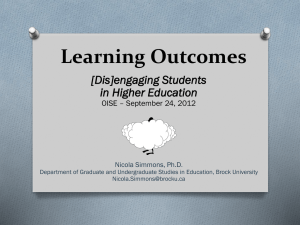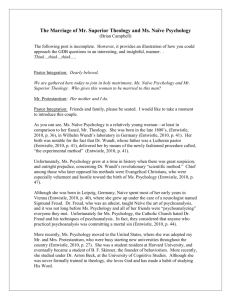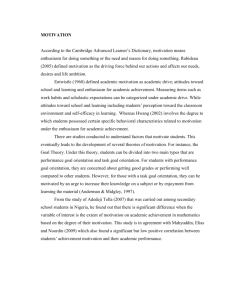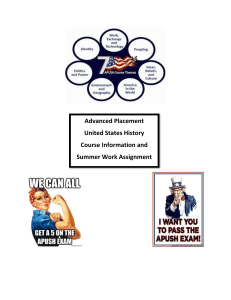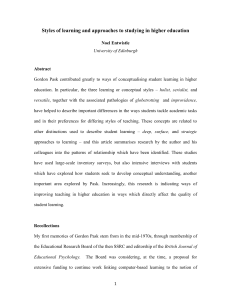MS Word - Christian Counseling and Christian Counseling Resources
advertisement
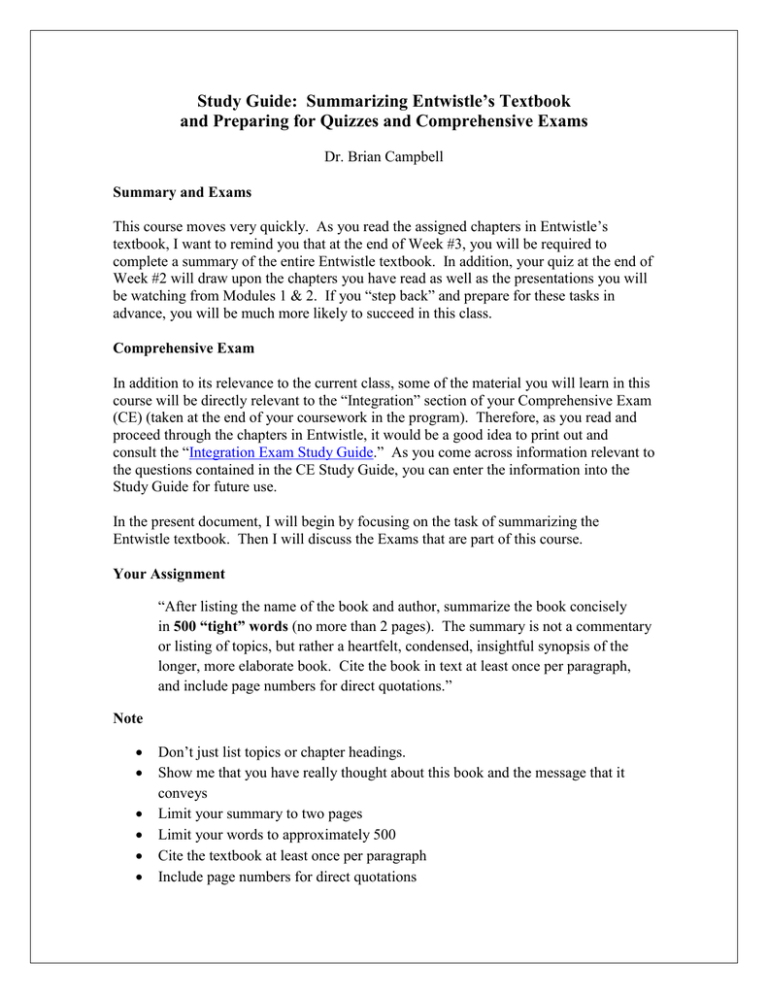
Study Guide: Summarizing Entwistle’s Textbook and Preparing for Quizzes and Comprehensive Exams Dr. Brian Campbell Summary and Exams This course moves very quickly. As you read the assigned chapters in Entwistle’s textbook, I want to remind you that at the end of Week #3, you will be required to complete a summary of the entire Entwistle textbook. In addition, your quiz at the end of Week #2 will draw upon the chapters you have read as well as the presentations you will be watching from Modules 1 & 2. If you “step back” and prepare for these tasks in advance, you will be much more likely to succeed in this class. Comprehensive Exam In addition to its relevance to the current class, some of the material you will learn in this course will be directly relevant to the “Integration” section of your Comprehensive Exam (CE) (taken at the end of your coursework in the program). Therefore, as you read and proceed through the chapters in Entwistle, it would be a good idea to print out and consult the “Integration Exam Study Guide.” As you come across information relevant to the questions contained in the CE Study Guide, you can enter the information into the Study Guide for future use. In the present document, I will begin by focusing on the task of summarizing the Entwistle textbook. Then I will discuss the Exams that are part of this course. Your Assignment “After listing the name of the book and author, summarize the book concisely in 500 “tight” words (no more than 2 pages). The summary is not a commentary or listing of topics, but rather a heartfelt, condensed, insightful synopsis of the longer, more elaborate book. Cite the book in text at least once per paragraph, and include page numbers for direct quotations.” Note Don’t just list topics or chapter headings. Show me that you have really thought about this book and the message that it conveys Limit your summary to two pages Limit your words to approximately 500 Cite the textbook at least once per paragraph Include page numbers for direct quotations 2 Keep this Assignment in Perspective Although summarizing a large textbook seems like a daunting task, your summary is intended to be concise. To put things in perspective, the first paragraph of this document contains nearly 100 words. For most of you, your problem will not be one of trying to “write more” or to find more things to say; instead, the problem will be one of trying to be concise, insightful, and “to the point.” In fact, you will probably find it extremely difficult to summarize such a great deal of information in such a limited space. This problem is reflected in the following famous quotation: “I would have written you a shorter letter, but I didn’t have time” (author unknown). Entwistle’s Textbook Getting the “Big Picture” Read the “Introduction” which appears on the front inside flap of the book cover. See if you can put in your own words the purpose of the book. Read the testimonials on the back cover of the book. Do these testimonials help you understand the purpose of the book? Read the author’s biography (inside flap of the back cover). What is the author’s background and training? How might the author’s education and professional training influence his writing? Read the Preface to the textbook. What does the author state that he is attempting to do in this book? Read the introduction to the book: “Introduction: The Fork in the Road.” The “Introduction” clarifies the author’s assumptions. Make a list of the author’s main assumptions regarding integration. Most of the chapters have a “Summary” section at the end. These chapter summaries will be especially helpful when attempting to complete your 4-MAT review. Things to Think About While Reading Entwistle’s textbook If you had to pick one word to describe the main theme of the book, what word would you choose? Basically, the entire book can be viewed as an argument for ___________. Now, go through and determine how Entwistle goes about justifying (arguing for) integration. How does he deal with objections to integration? What is his chief argument for integration? “All ______ is God’s _______.” Why does he feel that integration is inevitable? How do worldviews affect the process of integration? Why does Entwistle deal with the topic of worldviews? 3 How does Entwistle rationalize different approaches to finding truth (science vs. hermeneutics) and how does the marriage of the two methods provide an “appealing” framework for integration? How do naturalism and supernaturalism lead to different ways of understanding the world? How do the assumptions underlying each approach affect the integration process? How does Entwistle use the “testimonials” at the end of the book to illustrate/justify integration? I will stop here so that you can use your own thinking skills. Basically, I am suggesting that your summary could be thought of as a tightly constructed narrative that “unfolds” Entwistle’s arguments for the integration of psychology and Christianity. I strongly suggest that you start by making “bullets” for all the points you want to make. Then organize the points and start to consider how you will move from one point to another as you “unfold” your narrative. Before you can write effectively, you need to know “where you are going.” Do not start writing until you can clearly see “the big picture” and understand how your narrative will flow from beginning to end. Make sure each paragraph links to the previous paragraph—with proper transitions--as you recap Entwistle's argument for integration. Some paragraph openings and transitions might look like this: Entwistle's opening argument for integration focuses on... Entwistle begins his argument for integration by focusing on... Entwistle then proceeds to... His next argument for integration focuses on... Perhaps his most cogent argument for integration... To further bolster his argument, Entwistle uses "testimonials" to... Preparing for Exams The exams in this course consist of multiple choice questions that are drawn from both the textbook chapters and the Blackboard presentations. Most students don’t realize that many of the test questions come from the presentations. A complete transcript of the presentations is available in the Course Spreadsheet. It is also possible to view the content of the presentations in the “Presentation Notes” that appear in the upper left hand corner of the presentations. I strongly advise that you download the complete transcripts from the following website links: Week #1 Presentation Transcripts and Slides 4 Week #2: Presentation Transcripts and Slides I also recommend that you review the test taking tips that are included in the following link: Test Taking Tips I hope this helps. Blessings, Dr. Campbell
